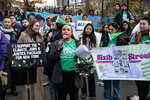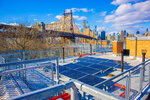A few of our stories and columns are now in front of the paywall. We at The Chief-Leader remain committed to independent reporting on labor and civil service. It's been our mission since 1897. You can have a hand in ensuring that our reporting remains relevant in the decades to come. Consider supporting The Chief, which you can do for as little as $3.20 a month.


Whether it’s the flooding of basement apartments in the outer boroughs, deadly blizzards in Buffalo, heatwaves on Long Island or wildfire smoke blanketing skies across the state, New Yorkers have increasingly felt the effects of a changing climate over the last two years.
And the effects are pushing environmental advocates to demand more ambitious legislation from lawmakers that reduce the states’ greenhouse gas emissions and encourage a transition to renewable energy sources.
But while they push for a transition to a green economy, community groups and labor unions have been warning that a shift from fossil-fuel dependent industries to green energy jobs in wind, solar and other categories of renewable power could leave behind New Yorkers who’ve worked in high-paying industrial jobs for years.
As a measure of protection for those workers, city lawmakers have authored legislation that would preserve the areas where these New Yorkers work, and a coalition that includes state legislators are urging Governor Kathy Hochul to pass several climate-related bills and allocate $1 billion in next year’s state budget for climate projects built mainly by union labor.
‘Fighting for a just transition’
“We have thousands and thousands of residents who every single year deal with flooding and poor air [quality] and the effects of our worsening climate crisis,” State Senator Kristen Gonzalez said earlier this month during a rally with several other lawmakers and the NY Renews Coalition. “We deserve climate justice as working New Yorkers.”
The coalition, made up of more than 370 labor, community, environmental and business organizations, organized the rally to launch the Climate, Jobs and Justice Package campaign that includes the $1 billion budget ask and a call for the state legislature to pass and the governor to sign three climate and jobs related bills.
The legislation would create a plan to redevelop New York’s oldest fossil fuel facilities, regulate gas facilities in line with emissions reduction targets and require the state’s Department of Environmental Conservation to collect a yearly fee from oil companies to pay for climate resiliency and repair projects. The projects present an opportunity for unionized construction laborers and to unionized workforces when they’re completed.
Brandon Mancilla, the director of United Auto Workers Region 9A, which represents workers in New York City, Long Island, New England and Puerto Rico, told The Chief following the rally that it’s crucial that workers are not left out of the green energy movement.
“We're fighting for a just transition, especially in the manufacturing sectors because that work needs to be good union work,” Mancilla said. “We have to make sure that environmental demands are also worker demands that are community-centric rather than pumping millions of dollars into companies without any checks or regulations."
Already, some renewable energy projects have drawn the ire of unions — workers in the International Longshoremen’s Association picketed for two months this fall at a Long Island a pier where offshore wind turbines were being installed — but Mancilla believes that worker organizing has shown that worker and environmental demands don’t necessarily have to be in conflict.
The six-week UAW strike at General Motors, Stellantis and Ford is evidence of both worker power and the harmony between the labor and environmental movements, Mancilla said, because the action pushed both GM and Stellantis to bring its electric battery plants under the UAW’s master agreement, ensuring that the next generation of workers making electric vehicles have union wages and protections. “It’s all about organizing,” he said, arguing that through a focus on climate workers can influence their bosses, politicians and the local community.
Local action
The City Council, too, has been looking for ways to protect high-paying industrial jobs while making the transition to a green economy. Council members on Nov. 15 passed a bill that will have the city create a comprehensive strategic action plan for the city's 17 industrial business zones.
These small pockets of land host workplaces that employ 470,000 people, and the Council-mandated plan seeks to ensure that the city has a comprehensive vision for keeping industrial jobs in place and creating more employment in renewable energy and environmentally friendly industries within those zones.
“To help more people reach their full potential and reach stability, it is imperative that we expand access to good paying jobs,” City Council Speaker Adrienne Adams said during a press conference before the Council’s vote. “This strategic plan will allow our city to invest properly in industrial businesses which can expand economic opportunities for New Yorkers, support our transition to green energy and create pathways to success.”
Adams said the bill was a “major priority” for her and the entire Council. Council Member Amanda Farías, one of the bill’s main sponsors, said the bill would help aid a “successful transition to the green economy.”
Mancilla, the UAW regional leader, said that lawmakers’ focus on ensuring that workers can transition to working in the green economy shows the influence that unions and workers have already had. “It’s important to understand the industry you work in and what your industry’s role is within the broader transition to a green economy,” he said.
“If there's no transition plan, then workers and communities are doomed."
dfreeman@thechiefleader.com
Comments
No comments on this item Please log in to comment by clicking here